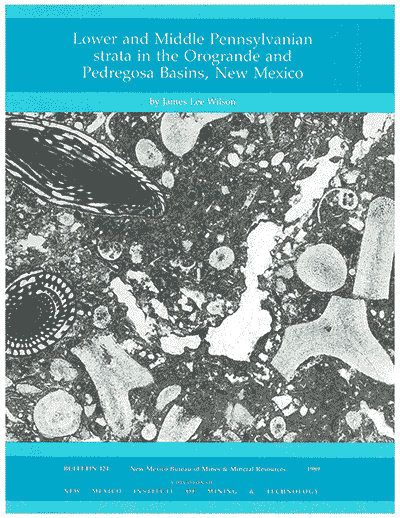
Bulletin 124—Lower and Middle Pennsylvanian strata in the Orogrande and Pedregosa Basins, New Mexico
By J. L. Wilson, 1989, 16 pp., 1 table, 6 figs.

This report appraises the depositional environment and potential reservoir development of Lower and Middle Pennsylvanian strata in and around the Orogrande and Pedregosa Basins in southern NM and northern Chihuahua, Mexico. A NE-SW cross section from the Sacramento to the Big Hatchet Mountains shows Lower and Middle Pennsylvanian carbonate and terrigenous rock types in detail, and an isopach and facies map shows their distribution. Compiled from years of investigation, the report will be an invaluable reference on carbonate petrography of Pennsylvanian strata for the region.
Lower Pennsylvanian and Middle Pennsylvanian strata are mostly carbonate in the southwest, unlike the dominantly terrigenous Lower and Middle Pennsylvanian in the mid-continent and eastern US. Thick sheets of Lower and Middle Pennsylvanian limestones covered most of the region from Oklahoma to NM, AZ, and the southern great Basin, and were present within the Ouachita-Marathon geosyncline. Studies of the region show that these limestones were part of a widespread carbonate platform that developed adjacent to the southwestern boundary of the late Paleozoic North American craton during Early and Middle Pennsylvanian time. The southwestern portion of the craton had remained relatively stable in early and medial Paleozoic time but near the end of Mississippian time it began to warp and break up. The platform was more intensely fragmented by Late Pennsylvanian and Early Permian rifting. The whole Paleozoic tectonic history, its causes and effects, are most recently discussed.
In southern NM, Tertiary basin-and-range faulting uplifted large areas and exposed fragmented sheets of Lower and Middle Pennsylvanian limestones throughout scattered mountain ranges. From the Sacramento to the Big Hatchet Mountains, eat and west of the Florida and Pedernal Uplifts, virtually complete sections of Lower and Middle Pennsylvanian strata crop out.
The lithofacies and thickness relations of these exposures demonstrate the presence of two Pennsylvanian-Wolfcampian basins of subsidence in the region: the Orogrande and Pedregosa. Kottlowski defined the basins as areas where 2,000 ft or more of sediments were deposited and where facies indicated only slightly deeper or more persistent water. The Orogrande Basin was named by Pray as extending from Rhodes Canyon in the San Andres Mountains southward to the northern Franklin Mountains eastward to the Sacramento Mountains, encompassing mostly Otero and Doña Ana Counties of NM. The Pedregosa Basin was defined as extending from the Gunnison Hills of Arizona southeastward to the Pedregosa Mountains of southeastern Arizona and Big Hatchet Mountains of southwestern NM and southward into northern Sonora. The Pedregosa Basin is now known to have formed a rather long, narrow flysch-filled trough during Early Permian time extending far southeast into Chihuahua. The Lower and Middle Pennsylvanian sections both in and around these basins are mostly carbonate except where clastics have been locally introduced.
$6.25
Buy
Now
Also available as a free download.
Download
| File Name | Size | Last Modified |
|---|---|---|
| B124_nc.pdf | 5.00 MB | 02/10/2021 03:47:10 PM |



